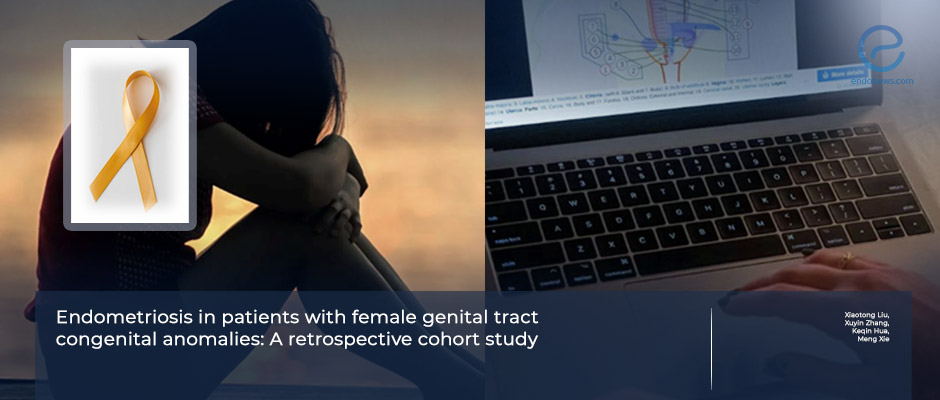High Endometriosis Risk in Obstructive Female Genital Tract Malformations: A 10-Year Surgical Cohort Study
Aug 13, 2025
High Endometriosis Risk in Obstructive Female Genital Tract Malformations: A 10-Year Surgical Cohort Study
Key Points
Highlights:
- Endometriosis is markedly more common and severe in women with obstructive genital tract anomalies, especially those involving the uterus or cervix.
Importance:
- Women with obstructive genital tract anomalies should be counseled about their elevated risk for endometriosis and monitored closely for early detection.
What’s done here?
- Single-center, retrospective cohort study of 675 women with female genital tract anomalies and functioning endometrium undergoing surgery (2013–2023).
- Patients classified by anomaly type (uterine, cervical, or vaginal) and obstruction status.
- Laparoscopic and histopathologic confirmation of endometriosis; severity graded using rAFS classification.
- Clinical parameters analyzed: age, cyclic abdominal pain, hematometra before surgery, dysmenorrhea scores, and anomaly type.
Key results:
- 675 patients who met the eligibility criteria included in the study.
- The incidence of endometriosis was significantly higher in patients with obstructive anomalies (52.1%) compared to those with non-obstructive anomalies (15.5%).
- Endometriomas were the most common type of endometriosis, accounting for 61% of all cases.
- The incidence and severity (rAFS scores) of endometriosis were significantly higher in patients with obstructive uterine or cervical anomalies than in those with obstructive vaginal anomalies.
- Age, cyclic abdominal pain, hematometra before surgery, and the specific type of obstructive anomaly were identified as significant risk factors for endometriosis in patients with obstructive genital tract anomalies.
- A positive correlation was found between cyclic abdominal pain and the severity of endometriosis by rAFS scores.
Strengths and Limitations:
- First large-scale analysis of endometriosis prevalence and risk factors in women with genital tract anomalies and functioning endometrium.
- Potential underestimation of prevalence since not all patients underwent laparoscopy.
From the Editor-in-Chief – EndoNews
"This large, well-characterized cohort delivers a critical message: congenital obstructive genital tract anomalies are not rare curiosities—they are potent drivers of endometriosis risk and severity. The threefold higher prevalence in obstructive versus non-obstructive malformations underscores the need for heightened clinical vigilance, particularly in adolescents and young women with severe cyclic abdominal pain.
These findings strengthen the retrograde menstruation hypothesis by demonstrating a clear anatomical pathway for menstrual outflow obstruction and subsequent ectopic implantation. They also refine our risk stratification, identifying preoperative hematometra, obstruction site, and pain severity as actionable red flags.
The clinical takeaway is unambiguous: timely recognition and surgical correction of obstructive anomalies may not only relieve symptoms but could alter the natural history of endometriosis. For gynecologic surgeons and reproductive specialists, this study sets a benchmark for integrating anomaly screening into early evaluation protocols."
Lay Summary
The link between female genital tract congenital anomalies and endometriosis is not fully understood, but these anomalies are known to increase the likelihood of retrograde menstruation—a key mechanism believed to contribute to the disease.
In a large retrospective cohort study titled “Endometriosis in patients with female genital tract congenital anomalies: A retrospective cohort study” and published in the Journal of Gynecology Obstetrics and Human Reproduction, Liu et al. from China analyzed data from 675 women with congenital genital tract anomalies and functioning endometrium who underwent surgery. They found that patients with anomalies causing obstruction had a markedly higher rate of endometriosis (52.1%) compared with those without obstruction (15.5%). The most common presentation was ovarian endometromas.
Obstructions located in the uterus or cervix carried greater risk and severity than those in the vagina. Key predictors of endometriosis included age, cyclic abdominal pain, preoperative hematometra, and the specific type of obstruction. Moreover, the severity of cyclic abdominal pain was positively correlated with the severity of endometriosis.
The authors stress that young women with severe cyclic abdominal pain should be evaluated for congenital anomalies to enable early diagnosis and intervention.
They note that further research is warranted to clarify the mechanisms linking these anomalies to endometriosis.
Research Source: https://pubmed.ncbi.nlm.nih.gov/40449888/
endometriosis female genital tract congenital anomalies revised american fertility society (rAFS) visual analogue scale (VAS) endometriosis fertility index (EFI)

